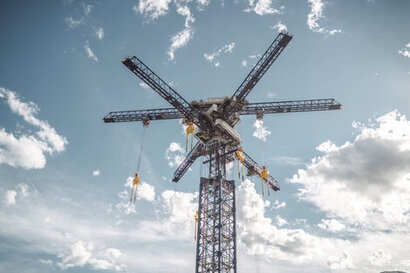
Wind power – and the number of clean energy-producing wind power plants – has increased new capacity by a record 53 percent in 2020 and is set to continue its exponential growth in the coming years. This is very good news on the renewables front but also brings with it a series of considerations that cannot be ignored: in particular, the need to identify circular solutions for when these plants are dismantled at the end of their life cycles.
This necessity, together with the important goals of decarbonisation and reaching net-zero emissions by 2050, is increasingly leading us towards the use of sustainable technologies for storing the energy necessary to make up for the wind’s inevitable intermittency. Wind power and energy storage have been brought together with the recent partnership agreement signed between Enel Green Power and Energy Vault, a Swiss technology company that specialises in gravitational energy storage systems. This partnership aims to integrate the gravity energy storage technology with the recycling of materials no longer needed at wind plants, applying a circular economy perspective across the entire wind power value chain.
For several years now, Enel Green Power’s Innovation unit has been hard at work scouting for new technological solutions for energy storage, with the goal of extending its own portfolio of solutions to complement lithium-ion batteries; the emphasis has been on safety and sustainability, especially concerning longer-lasting systems.
As part of this research, in 2019, EGP became aware of Energy Vault, whose solution for storing energy employs purely mechanical technology and is inspired by hydroelectric plants, which take advantage of gravitational forces and the movement of water masses to store and release energy on demand. Instead of water, however, Energy Vault uses blocks of solid material, as a storage medium. These large blocks, weighing around 35 tons each, are lifted to store electricity when an excess of energy is produced and then when electricity is required, the blocks are lowered, exploiting the force of gravity to generate electricity as they descend. The entire operations are orchestrated by proprietary software and computer vision that control the velocity and movement of the blocks.
The benefits of this solution are the same as those of a pumped storage hydro plant, but at a much lower cost, with greater possibility of being replicated in any geographical context and greater efficiency: the Energy Vault technology can even exceed an efficiency level of 80 percent. Moreover, there are clear benefits compared to batteries: a plant of this type is not exposed to storage medium degradation (no need for augmentation over time), risk of fire, has a long lifespan of 30-35 years and its eventual dismantling will not pose particular difficulties, as the blocks are composed of inert materials and are created directly on site.
Energy Vault has already interconnected a 5 MW Commercial Demonstration Unit (CDU) of the gravity storage technology in Ticino, and recently announced the new EVx product platform (a 30 story building architecture, 40 percent shorter and fully flexible in terms of charging and discharging duration), ideal for the utilisation of wind blade fibres. The agreement signed with Enel Green Power has a series of successive steps planned.
“The first phase included a detailed analysis of the technology at the first commercial system in Switzerland (grid connected in July 2020), and is followed now by a feasibility study for the creation of an initial commercial plant with an energy capacity in the order of a few dozen megawatt hours” said Pasquale Salza, Head of Energy Storage & Hybrid Systems at EGP’s Innovation function. “If everything goes well, by the end of this year we may be able to conclude the feasibility study with a positive outcome for the construction of the EVx plant.”
Marco Terruzzin, Chief Product Officer of Energy Vault added that the mission is to bridge the remaining gap in the clean energy pipeline by providing cost-effective and sustainable energy storage solutions, accelerating the usage of recycled materials for Energy Vault’s units.
The question of dismantling wind plants is becoming more pertinent than ever: the average useful life of wind turbines is around 20 years and the first generators were installed at the beginning of the 2000s. For this reason, Enel Green Power has already been working for some time to identify strategies for the effective reuse of all the components of these power plants. The problem, however, mainly concerns the turbine blades, which are made of composite material reinforced with fiberglass and/or carbon fibre, which is currently difficult to retrieve for recycling or reuse.
One possible solution, which is currently in the demonstration phase, is the ‘shredding’ of the obsolete blades and their redeployment, in the form of secondary raw materials, for making products for other sectors, such as the construction industry or furniture manufacturing. Based on this experience, another innovative idea came about: the integration of composite material from the former turbine blades into the blocks used by Energy Vault for gravitational storage.
“The use of this material gives the blocks greater stability and robustness, increasing their durability and further lowering costs” said Irene Fastelli, Head of the Innovation Factory for the O&M and HSEQ functions at EGP. “The partnership with Energy Vault involves feasibility studies for integrating the composite material from Enel Green Power’s decommissioned turbine blades into the blocks used by the energy storage system. All of this occurs as part of a circular process, which includes the decommissioning of the wind plant, the treatment of the composite material at a shredding plant, its processing and reintegration into the energy storage system”.
For additional information:

